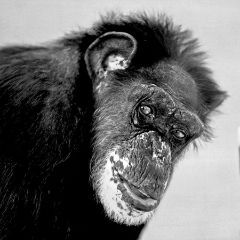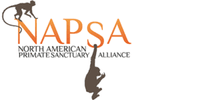DONNA RAE

1966–2005
The first time I met Donna Rae, I was taken aback. Donna Rae looked human, her mannerisms, her posture and all her gestures were those of humans. I remember feeling embarrassed, and guilty to be standing outside of her tiny cage and being afraid to connect with her, for fear she would see inside of me, and I would not be able to explain to her what happened. I didn’t know how someone could take her and lock her up and do such terrible things to her. We both knew she should not be in that cage. She had been tricked and betrayed, and she knew it.
Donna Rae came from a very sad, disturbing but common situation. She was “cross-fostered,” meaning she was raised in a human environment, as a human child. In some cases cross-fostered chimpanzees are not only raised by adult humans but are raised with a child as a companion, like a sister. Such was the case for Donna Rae.
This kind of upbringing has been shown over and over again to be tragic and sad. It is a truly unnatural environment for a young chimpanzee to grow up in. Not only does it put the chimpanzee in the most unforgiving of all environments, it also has adverse affects on the humans.
Over the years we have read about and witnessed many individuals who have lived this way. Some in “research environments,” studying the development of the chimpanzee and some in rather accidental and unplanned situations, like Donna Rae.
She was somehow in the wrong place at the wrong time, purchased as a baby, most likely from Africa. She was then traded and placed in the hands of Elizabeth Hammond and the Animal Kingdom Talent Services, “animal lovers” with a variety of exotic creatures from bears to elephants. Donna Rae would be part of the collection and used to attract some attention and some funds — that is if she could do anything interesting.
She was small and needed a great deal of attention. The easiest thing to do was place her with the young child in the family so the two could amuse each other and reduce the strain on the baby chimpanzee, who needed so much more than she was getting. So the little girls grew up together: played together, ate together, wore the same dresses and shoes, learned to ride bicycles at the same time, raided the refrigerator with the help of Donna Rae’s long arms. They eventually became inseparable friends. They were, in a sense, sisters. That is, until that day, the day that always comes, when Donna Rae was becoming stronger and more dangerous. She was not mean, not violent, just a normal, young chimpanzee reaching sexual maturity and changing. She could no longer live with a human child.
So Donna Rae was locked up and did not have the opportunity to play with her human sister and friend without bars between them. She understandably got angry. She was hurt and confused. So many of the chimpanzees that have been raised in this way are very traumatized and remain confused and lost forever. They are stuck between two worlds: that of human and that of chimpanzee. These chimps have often never even met another of their own kind, living years without laying an eye on a fellow chimpanzee. The first time chimpanzees from private ownership meet other chimpanzees, many have no idea what they are and have no way of communicating with them. They have great difficulty when they are expected to live and socialize with their natural families.
It is rare that we see cross-fostered chimps ending up in zoos as these exhibitors do not wish to see human-like behaviors from the chimps, preferring their more “natural behaviors”…if that can even happen in a “fabricated” environment. Sadly, the choice most owners were left with back then was to send their chimpanzee into research. There were not a lot of sanctuaries at that time and the ones that were around were at full capacity. In those days it was always the laboratories that would accept a chimp that had been raised by humans. Nowadays, the sanctuaries do their best to place as many chimpanzees as we can from this environment. In some cases, we prefer to leave them in the home environment if they are well cared for because we understand how difficult it can sometimes be for these individuals to adapt to sanctuary life with other chimpanzees.
Donna Rae was 12 years old when Elizabeth Hammond sold her to LEMSIP for $1,000.00. The transaction shows that Elizabeth Hammond delivered Donna Rae on January 4, 1978 and that she walked into the lab. They also noted that a promise was made to Mrs. Hammond that Donna Rae would get her favorite foods, that she would get to go out for walks and that she would go into the “breeding program” instead of being used for invasive biomedical research.
Donna Rae did not get out of her cage and go on walks. She did not get peanut butter and jelly sandwiches. And she was used in the worst of all research: she was infected with the HIV virus and subjected to horrible procedures over 19 long years and endured unimaginable cruelty, both emotionally and physically. Donna Rae went into the lab when she was 12 years old and she spent the following 19 years in a 5’x5’x7′ cage. She then arrived at Fauna, where we had the honor of her company for just eight short years.
Donna Rae’s human sister never really knew where Donna Rae was taken until many years later, learning of her whereabouts while reading and seeing her name on the Internet. She contacted me to tell me her story and I was grateful to have her fill in the blanks and to know more of Donna Rae’s past. I also learned of the love she and her chimpanzee sister had for one another. It was such a tragic end to their story.
Donna Rae was a kind and loving soul who trusted people because she was a person in her early life. To imagine her being locked up and put into research for so much of her life is unimaginable. She lived alone in a small cage with no friends and no choices. Over 19 years she was subjected to numerous and very painful medical procedures, including a vaginal examination where the scope was so large it sent her into shock.
For Donna Rae and others like her, the only time she was not alone was when she would be forced to endure the visits of male chimpanzees that would try to mate with her. She never had children and she never tolerated males bothering her. She adored her best friends Sue Ellen, Pepper and Annie. She found comfort in her relationships with Pablo, Yoko and Tom.
The tragedy of Donna Rae’s story continues with so many other chimpanzees that walk in her footsteps. We must always remember when we hear of people who own and raise chimpanzees for fun, mistakenly thinking that they can provide well for them, that it will almost always certainly end badly. Chimpanzees should live with chimpanzees and we must remain conscience of that. Whenever possible, we must let them be with their own kind.
Donna Rae was stuck between the worlds of humans and chimpanzees, destined to live a life where she would never fit in.
“Real strength is not just a condition of ones muscle, but a tenderness in one’s spirit.” –McCallister Dodds





